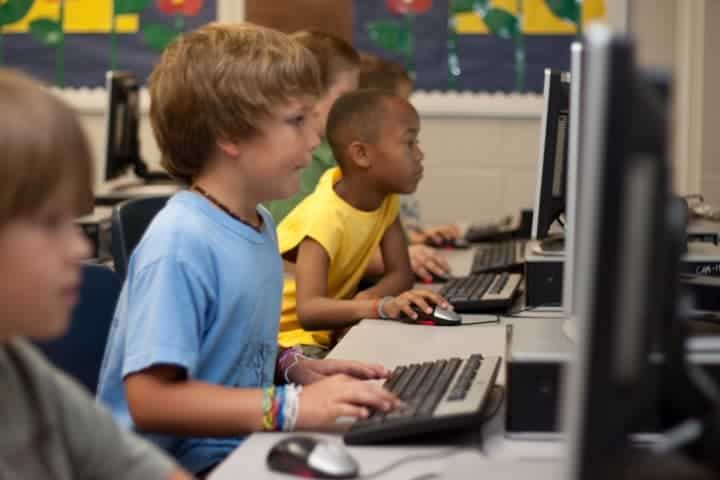In today’s digital age, the internet has become a significant part of our lives, including our children’s. While it offers numerous benefits, it also presents unique challenges and risks. This article aims to guide parents on how to protect their children online.
Understanding the Digital Landscape
In the digital age, children are growing up in a world vastly different then we did. The internet, with its endless resources and opportunities for connection, has become a significant part of their lives. As parents, understanding this digital landscape is the first step towards ensuring your child’s online safety.
The Internet and Social Media

Children use the Internet for all sorts of things. It’s a platform for learning where they can access educational materials, tutorials, and online classes. It’s also a space for socializing, where they can connect with friends, join online communities, and express their thoughts and creativity.
Social media platforms, in particular, have become a popular way for kids to interact with the world. Sites like Instagram, Snapchat, and TikTok allow them to share photos, videos, and messages with their peers. They can follow their interests, join groups of like-minded individuals, and even participate in global conversations.
However, these platforms also expose children to potential risks. They might encounter inappropriate content, receive messages from strangers, or become targets of online harassment. Furthermore, the pressure to gain likes, followers, or comments can lead to stress and anxiety.
As a parent, it’s important to be aware of these risks and guide your child in navigating these platforms safely.
Online Gaming and Cyberbullying

Online gaming is another common activity among children. Games like Fortnite, Minecraft, and Roblox are not just about entertainment; they also offer opportunities for social interaction. Players can team up with friends from school, play against others, and be part of a global gaming community.
However, just like social media, online gaming can also be a platform for cyberbullying. Players can send hurtful or offensive messages during a game, exclude others on purpose, or even steal and destroy virtual possessions. Some games also have chat features that can expose your child to inappropriate language or content.
Understanding these platforms and their potential risks is crucial for parents. It’s not about banning your child from these activities, but rather teaching them how to enjoy these platforms responsibly and respectfully. This includes setting rules for gaming, discussing online etiquette, and encouraging them to speak up when they encounter bullying or other issues.
Risks and Dangers Online
- Understanding Online Risks: The internet, while beneficial for education and communication, also presents risks and dangers. Children may encounter situations online that they are not equipped to handle, making it crucial for parents to understand these risks and take appropriate measures to safeguard their children’s online experiences.
- Privacy Concerns: Children may not fully understand the concept of online privacy and could inadvertently share sensitive information that malicious individuals could misuse. Additionally, many online services collect user data, potentially exposing children to targeted advertising and other risks.
- Inappropriate Content: The internet hosts a vast array of content, not all of which is suitable for children. Without proper supervision, children might encounter violent or sexually explicit content, hate speech, harmful ideologies, or dangerous behaviors. It’s essential to guide children in navigating the internet safely and responsibly.
The internet, while a powerful tool for education and communication, also harbors risks and dangers that children may not be equipped to handle on their own. As parents, understanding these risks is crucial to effectively safeguarding our children’s online experiences.
Privacy Concerns for Kids
Children, especially younger ones, may not fully grasp the concept of privacy, particularly in the context of the internet.
They might inadvertently share sensitive information such as their full name, address, school, or even photos that malicious individuals could misuse. This could lead to identity theft, cyberstalking, or other forms of exploitation.
Moreover, many websites and online services collect data from their users. Children may not understand what information is being collected, how it’s being used, or how to opt-out. This lack of privacy can expose them to targeted advertising and other potential risks.
Inappropriate Content
The internet is a vast repository of information, but not all of it is suitable for children. They might stumble upon violent or sexually explicit content, hate speech, or other harmful material. Even seemingly innocent platforms like video-sharing sites or social media can host inappropriate content.
Furthermore, the internet can also expose children to harmful ideologies or dangerous behaviors, such as self-harm, substance abuse, or extremism. Without proper supervision and guidance, children might take these harmful messages to heart.
Essential Online Safety Measures

- Proactive Online Safety Measures: Protecting your child online involves not only understanding the risks but also taking proactive steps to mitigate them. This includes setting boundaries, establishing rules, and using parental control tools.
- Setting Boundaries and Rules: Establish clear rules about internet use, such as limiting screen time and restricting access to certain websites. Teach your child to respect others online, avoid sharing personal information, and report any uncomfortable encounters.
- Using Parental Controls: Parental control tools can help safeguard your child’s online activities by blocking inappropriate content, limiting screen time, and monitoring online interactions. However, these tools should be used in conjunction with open communication and guidance about online safety.
Protecting your child online isn’t just about understanding the risks—it’s also about taking proactive steps to mitigate them. Here are some essential measures that parents can take.
Setting Boundaries and Rules
Establishing clear rules about internet use is a vital step in protecting your child online. This could include limiting screen time to ensure a healthy balance between online and offline activities.
It could also involve restricting the use of certain websites or platforms that are known to host inappropriate content or pose other risks.
Setting guidelines for online interactions is also important. Teach your child to treat others with respect, to avoid sharing personal information, and to come to you if they encounter anything that makes them uncomfortable.
Using Parental Controls
Parental control tools can be a valuable ally in safeguarding your child’s online activities. These tools can block access to inappropriate content, limit screen time, monitor online interactions, and even track your child’s location for safety.
For instance, you can use these tools to filter out adult content from search results, limit access to certain apps during homework time, or keep track of your child’s social media activity. Remember, though, that these tools are not a substitute for open communication and guidance. They’re best used in conjunction with ongoing conversations about online safety.
Children possess unique learning styles. Ensure you’re catering to your child’s specific needs with our insightful article, ‘Deciphering Diverse Learning Styles in Children.’
The Role of Schools in Online Safety
- Schools’ Role in Online Safety: Schools play a significant role in children’s online safety as they often have access to the internet for educational purposes during school hours. It’s crucial for schools to implement effective internet use policies and foster collaboration with parents to ensure students’ online safety.
- School Policies on Internet Use: Clear policies on Internet use should be established and communicated to both students and parents. These policies, which may include rules about website access and acceptable online behavior, should be regularly reviewed and updated. Parents should be informed of any changes and have the opportunity to provide input.
- Collaboration with School Staff: Collaboration between parents and school staff is key to online safety. Regular communication with teachers and administrators can provide valuable insights into a child’s online behavior at school and alert parents to potential issues. Schools may also offer resources to help parents manage their child’s online safety at home.
Schools play a significant role in children’s online safety. As children spend a substantial portion of their day in school, where they often have access to the internet for educational purposes, it’s crucial that schools have measures in place to ensure their online safety. This involves implementing effective internet use policies and fostering collaboration between parents and school staff.
School Policies on Internet Use
Schools should have clear policies on internet use that are communicated to both students and parents. These policies might include rules about which websites can be accessed on school computers, what kind of online behavior is acceptable, and the consequences for violating these rules.
For example, schools might use internet filters to block access to inappropriate content. They might also monitor students’ online activities during school hours to prevent cyberbullying and other harmful behaviors.
These policies should be regularly reviewed and updated to keep up with the rapidly changing digital landscape. Parents should be informed of any changes and should have the opportunity to provide input on these policies.
Collaborating with Teachers and School Administrators
Collaboration between parents and school staff ensures children’s online safety. Teachers and school administrators can provide valuable insights into your child’s online behavior at school and can alert you to any potential issues.
Regular communication with your child’s teachers can help you stay informed about what your child is learning about online safety at school. You can also share your own concerns and suggestions.
In addition, schools might offer resources to help parents manage their child’s online safety at home. This could include educational materials, workshops, or referrals to outside experts.
The Impact of Screen Time on Children
In the digital age, screen time has become a significant part of children’s lives. While screen time can offer educational and recreational benefits, it’s important to consider its potential impacts. Excessive screen time can have various effects on children, and balancing it with physical activity is crucial for their overall well-being.
The Effects of Excessive Screen Time
Excessive screen time can have several potential effects on children. On a physical level, it can lead to sedentary behavior, which is associated with obesity and other health problems. It can also strain the eyes, leading to issues like dryness, irritation, and nearsightedness.
On a cognitive and emotional level, excessive screen time can affect children’s sleep, attention, learning, and mental health. For instance, using screens close to bedtime can interfere with sleep quality and duration.
Spending a lot of time on fast-paced, reward-driven games can affect attention span and patience. Over-reliance on digital devices for entertainment can also limit opportunities for creativity and independent play.
Furthermore, spending a lot of time online can expose children to harmful content and risky interactions, which can lead to stress, anxiety, or other mental health issues.
Balancing Screen Time with Physical Activity
Balancing screen time with physical activity is essential for children’s health and development. Regular physical activity promotes cardiovascular health, improves strength and coordination, and supports mental well-being. It also provides opportunities for social interaction and skill development.
Parents can set rules for screen time, such as no screens during meals or before bedtime, and encourage regular breaks during long periods of screen use. They can also make sure that children have plenty of opportunities for physical play and exercise.
For instance, parents can encourage children to participate in sports or other physical activities, arrange playdates with peers, or plan family outings that involve physical activity, like hiking or biking. They can also provide toys and materials that promote active and creative play, like balls, bikes, art supplies, and building blocks.
Remember, the goal is not to eliminate screen time, but to ensure it’s part of a balanced lifestyle that includes physical activity, social interaction, and other forms of learning and play.
Educating Your Child About Online Safety
While setting boundaries and using parental controls are important, they are not enough on their own. Education is a key component of online safety. Children need to understand the risks and learn how to navigate the online world responsibly. This involves open communication and teaching critical thinking skills.
Importance of Open Communication
Open communication is the foundation of online safety education. It’s important to create an environment where your child feels comfortable discussing their online experiences, both positive and negative. This means not just talking, but also listening.
Show interest in what they do online, the games they play, the websites they visit, and the friends they make.
Encourage them to share any concerns or issues they encounter online. This could be anything from a confusing message they received, a disturbing video they saw, or a conflict with an online friend. Make sure they know that they can come to you with these issues, and that you will help them without judgment or punishment.
Regular discussions about online safety can also be beneficial. Talk about the latest online trends, risks, and safety measures. Use real-life incidents as teachable moments. The goal is to keep the lines of communication open and ongoing.
Teaching Critical Thinking
Critical thinking is a vital skill in the digital age. With so much information at their fingertips, children need to learn how to evaluate the credibility and reliability of the information they encounter online.
Teach your child that not everything they read online is true. Show them how to check facts, verify sources, and question the motives behind the information. Explain how rumors and misinformation can spread online, and how they can contribute to a safer online environment by not sharing unverified information.
It’s also important to teach them about online scams. Explain how phishing works, what red flags to look out for, and what to do if they suspect a scam. This includes suspicious emails, too-good-to-be-true offers, and requests for personal information.
By teaching critical thinking, you’re not just protecting your child online. You’re also equipping them with skills that will serve them well in all areas of life.
FAQs – Protecting Your Child Online: Safety Measures for Parents
What Are Some Signs That My Child Might Be Experiencing Cyberbullying?
Signs can include changes in mood, reluctance to use the internet, and secretive behavior.
How Can I Monitor My Child’s Social Media Use Without Invading Their Privacy?
You can use parental control tools, follow or friend them on social media, and have regular discussions about their online activities.
What Should I Do If My Child Encounters Inappropriate Content Online?
Talk to them about what they saw, explain why it’s inappropriate, and report the content.
How Can I Teach My Child About Online Privacy?
Explain the importance of not sharing personal information online and show them how to use privacy settings on social media.
What Are Some Reliable Parental Control Tools?
Some reliable tools include Net Nanny, Norton Family, and Qustodio.
Wrapping Up Protecting Your Child Online: Safety Measures for Parents
Protecting your child online is a shared responsibility between parents and children. By understanding the digital landscape, setting clear rules, using parental controls, and maintaining open communication, parents can significantly reduce the risks their children face online.
Discover the optimal routine and insightful tips for your children’s study time. Dive into our enlightening article, ‘Crafting Efficient Homework Routines for Kids‘ for a successful academic journey.


